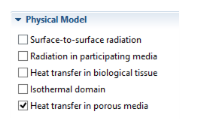The Heat Transfer in Porous Media interface (

), found under the
Heat Transfer branch (

) when adding a physics interface, is used to model heat transfer by conduction, convection, and radiation in porous media. A
Porous Medium model is active by default on all domains. All functionality for including other domain types, such as a solid domain, is also available.
The physics interface is an extension of the generic Heat Transfer interface. When this physics interface is added, the following default nodes are added in the Model Builder:
Porous Medium,
Thermal Insulation (the default boundary condition), and
Initial Values. Then, from the
Physics toolbar, add other nodes that implement, for example, boundary conditions. You can also right-click
Heat Transfer in Porous Media to select physics features from the context menu.
When the Subsurface Flow Module is added, under Physical Model, select
Extended from the
Porous matrix model list to use a version of the matrix feature to account for multiple immobile solids and fluids, as well as for geothermal heating.

